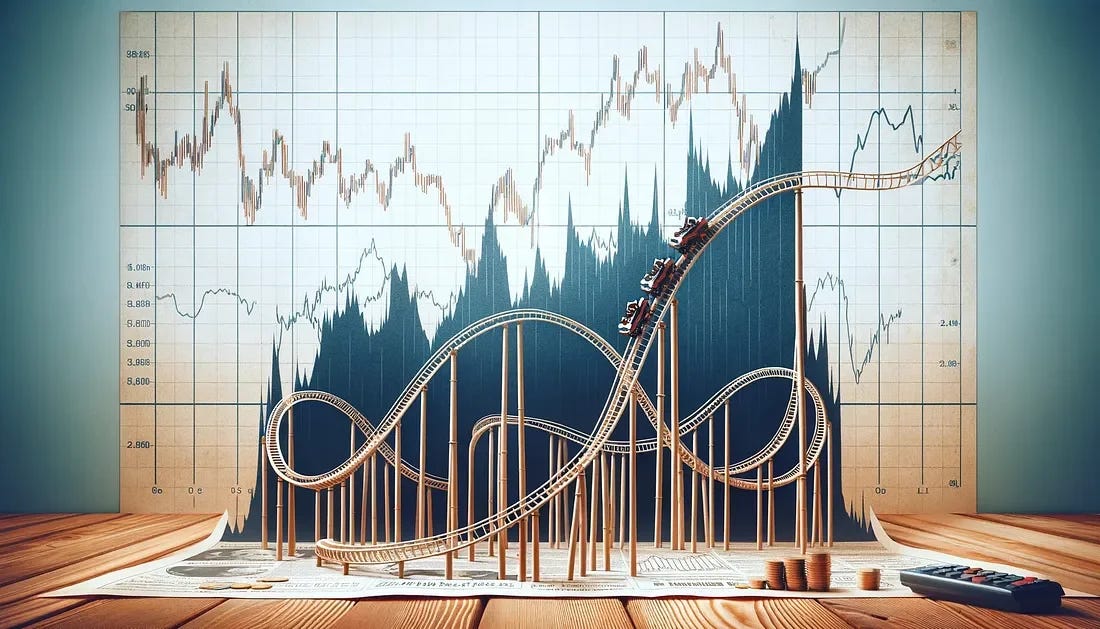Market Pulse: CPI Does Not Matter
In 8 minutes, let me explain why the market moved the way it did today, why the CPI didn't really matter, and where it might be heading.
In 8 minutes, let me explain why the market moved the way it did today, why the CPI didn't really matter, and where it might be heading.
The market sold off yesterday with SPY down 1.4% and QQQ down 1.5%.
The VIX (S&P 500 volatility index) went up almost 28% since Monday’s close and it’s up 38% since Friday’s close.
In this issue, we’ll try to answer these questions:
Why did the market sell off?
What caused this heightened volatility?
And is this the start of a broad market sell-off?
Let’s start.
This morning the February VIX futures expire.
There’s one VIX futures expiry every month and in the past few months this expiry date has resulted in significant stock market volatility.
For example, the market fell 2% after VIX expiry in December and it made a similar move around January’s VIX expiry.
The good news is that we’ve been warning subscribers of this rise in volatility and we were well positioned to capitalize on this large spike in the VIX.
Last week, we shared with premium subscribers a long VIX position where we bought calls on UVXY, a 1.5x ETF for the VIX. These paid off in spades near the peak of VIX today (+$2,087.60 or +380%).
Here’s a quick explainer on the VIX, VIX futures, and possible market flows near VIX expiry.
💡 VIX, VIX Futures, and VIX expiry
VIX
The VIX is an index that aims to track the implied volatility of the S&P 500.
Implied volatility is, in simple terms, how much the market expects the index will move in the near-future.
If, for example, a large market moving event is approaching like a Fed FOMC meeting, the implied volatility will be higher. If there’s nothing coming up in the economic calendar, implied volatility will be lower.
The VIX is calculated through a complex formula of (very roughly) averaging the prices of a bunch of SPX options with expiry dates up to a month out from now.
For example, the SPX is at 5,000.62 today and so the current VIX value could be calculated by averaging the prices of SPX call and put options with strikes prices ranging from 4,500 to 5,500 and expiry dates ranging from tomorrow to mid-March.
VIX Futures
VIX futures, on the other hand, is like a prediction market for the VIX index.
Remember, the VIX is calculated using the prices of a bunch of SPX options that expire between now and a month out.
There’s a VIX futures product that expires each month for roughly the next 8 months. At expiry, the actual VIX value is used to determine how money exchanges hands for traders of the expiring VIX product.
VIX Futures Expiry
Because VIX futures are settled based on the value of the VIX at expiry date,
And the VIX is calculated based on the price of SPX options,
Interesting trading opportunities arise as we near the VIX futures expiry date. Specifically, I’m talking about arbitrage opportunities.
If the VIX futures is trading higher than the current VIX value as we approach expiry,
What traders could do (usually these are sophisticated traders like hedge funds) is buy strips of SPX options that approximate the value of the VIX and
subsequently sell VIX futures to arbitrage this price gap between the futures and the actual VIX.
Vice versa if the VIX futures is trading lower.
For this February VIX futures expiry, we saw that VIX futures were trading significantly higher than the VIX in the week leading up to expiry.
We thought that this will likely cause the VIX to move up to converge with VIX futures as the expiry date approached due to the arbitrage trade. That’s why we bought UVXY calls.
This turned out to be right. The VIX shot up 38% since the Friday close.
This huge move in the VIX then caused it to overshoot VIX futures and the VIX subsequently fell off in the last hour of trading, as expected, to converge with VIX futures.
This explains why the S&P 500 sold off during the day and then bounced up in the last hour of trading.


The general principle is that when the VIX rises, the S&P 500 falls.
A simple reason for this is that the, even though there’s duality to volatility (upside and downside), the market doesn’t like volatility.
Aligning with this principle, we saw the S&P 500 fall as the VIX spiked on Tuesday and then rise again as the VIX fell in the last couple hours of trading.
💡 What about the CPI?
We got January’s CPI number yesterday and it came in slightly hotter than expected at 3.1% year-over-year. The market was expecting 2.9%. However, this is still lower than last year January’s 3.4% number.
Some would blame yesterday’s market sell-off on this hotter-than-expected CPI print.
We don’t think so.
First, let’s put the number in perspective. January’s CPI was only 0.2% higher than the market consensus. A grand 0.2%!
Second, the Fed doesn’t use the CPI to measure inflation given flaws in how it’s calculated (e.g. doesn’t account for goods substitution). The Fed prefers the PCE instead.
Third, the bond market barely blinked in reaction to this higher-than-expected CPI print. The 10-year treasury yield rose just 3% or 12 basis points from 4.15% to 4.28%.
The 10-year treasury yield is a good measure of the bond market’s long-term expectation for inflation.
Furthermore, the market’s swift recovery at the tail-end of yesterday’s trading session, and this morning, suggests yesterday’s sell-off was a short-term phenomenon.
As such, even though the CPI might’ve induced some headline selling, we think that the sell-off was largely driven by the impending VIX futures expiry today, similar to how the market briefly sold off on the last few VIX futures expiry dates.
💡 Is this the start of a broad market sell-off?
We don’t think the hotter-than-expected CPI print mattered much for the market sell-off yesterday but that doesn’t mean we’re not nearing a near-term local maximum for the market.
We just don’t think that yesterday is the trigger.




